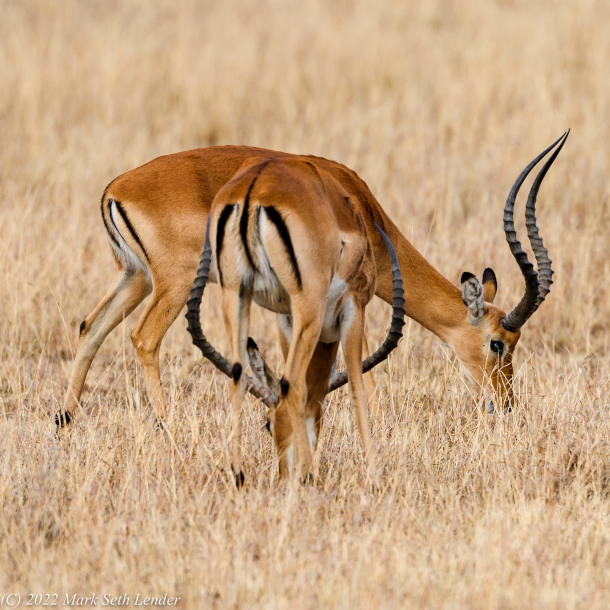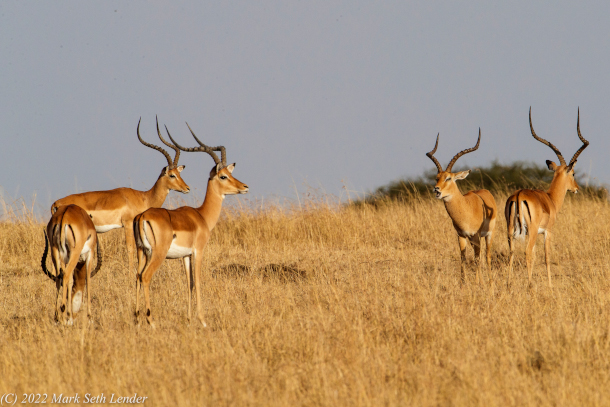The Impala Imperative
Air Date: Week of March 11, 2022

Two impala face each other in tall grass. (Photo: © Mark Seth Lender)
Living on Earth's Explorer-In-Residence Mark Seth Lender shares the secret of how impala antelope living on the African savanna confuse predators.
Transcript
DOERING: Prey animals have evolved many ways to confuse their predators, from a zebra’s stripes to an impala’s back side. Living on Earth’s Explorer in Residence, Mark Seth Lender explains.
The Impala Imperative
© 2022 Mark Seth Lender
All Rights Reserved
They are magnificent. Common they may be but it is impossible not to feel overawed watching them now on a slope of the rounded hill where they stand in high relief, five in number, their name an onomatopoeia:
Immm-PaLa!! Immm-PaLa!! Immm-PaLa!! Immm-PaLa!! Immm-PaLa!!
You can see them, in that name, bounding across the veldt in sure-footed certainty and grace. In their grass-colored coats even as they graze walking slow their muscles, tight and masculine beneath the skin imply –
Immm-PaLa!!

Impala standing near each other create a camouflage effect. (Photo: © Mark Seth Lender)
The females were in that very same place not an hour before. All in a herd of their own. Not like the males who are only near the crest but right on top. Rather to be seen. Than take a chance on hiding low on one side or the other and miss an otherwise apparent danger. With a clear view they see very well. Their legs are very long. No doubt they feel they can outrun anything that comes after them. In aspect, except for a subtle difference in proportion and a hidden capacity for speed, they could be white-tailed deer.
You would never make that mistake with the males. They are what they are. Their horns are nearly half the length of them and ribbed and strong, they curve and curl like an ancient casting made of bronze, the maker and his art lost in history. They stand tall when they stand, their eyes bright as windows; they call to each other mouths open wide.
Unassailable.
As if they have a talisman.
As if they have a secret.
And they do:
The dark black markings on their buttocks are shaped to the same color and curve as those brazen horns. But upside down! When they bow, to nibble grass, head turning one side to the other to graze, from the perspective of some predator lying in wait, lying low, those horns and these hindmost markings cross.

A herd of impala walk the savanna. (Photo: © Mark Seth Lender)
Confusion!
All the more so when two or three impala are together. Horns high horns low horns crossed and crossing and turning.
“Impa – La? Impa – Low? Impa – LUNGE? No… I don’t think so.”
Early morning and just barely light there they are again, all five, ambling at leisure, chewing the grasses wet with mist close along the trees, in all their confidence and strength. Or is it acceptance? No magic is perfect.
DOERING: That’s Living on Earth’s Explorer in Residence Mark Seth Lender.
Links
Read Mark's field note for this essay
Living on Earth wants to hear from you!
Living on Earth
62 Calef Highway, Suite 212
Lee, NH 03861
Telephone: 617-287-4121
E-mail: comments@loe.org
Newsletter [Click here]
Donate to Living on Earth!
Living on Earth is an independent media program and relies entirely on contributions from listeners and institutions supporting public service. Please donate now to preserve an independent environmental voice.
NewsletterLiving on Earth offers a weekly delivery of the show's rundown to your mailbox. Sign up for our newsletter today!
 Sailors For The Sea: Be the change you want to sea.
Sailors For The Sea: Be the change you want to sea.
 The Grantham Foundation for the Protection of the Environment: Committed to protecting and improving the health of the global environment.
The Grantham Foundation for the Protection of the Environment: Committed to protecting and improving the health of the global environment.
 Contribute to Living on Earth and receive, as our gift to you, an archival print of one of Mark Seth Lender's extraordinary wildlife photographs. Follow the link to see Mark's current collection of photographs.
Contribute to Living on Earth and receive, as our gift to you, an archival print of one of Mark Seth Lender's extraordinary wildlife photographs. Follow the link to see Mark's current collection of photographs.
 Buy a signed copy of Mark Seth Lender's book Smeagull the Seagull & support Living on Earth
Buy a signed copy of Mark Seth Lender's book Smeagull the Seagull & support Living on Earth

